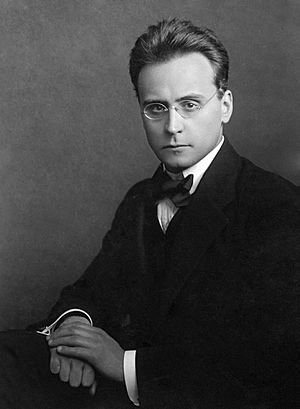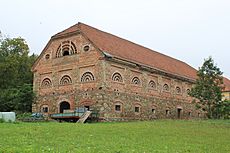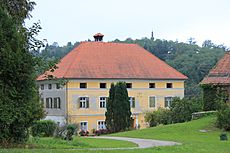Anton Webern facts for kids
Quick facts for kids
Anton Webern
|
|
|---|---|

Webern in Stettin, October 1912
|
|
| Born | 3 December 1883 Vienna, Austria
|
| Died | 15 September 1945 (aged 61) Mittersill, Austria
|
| Occupation |
|
|
Notable work
|
List of compositions |
| Signature | |
Anton Webern (born December 3, 1883 – died September 15, 1945) was an Austrian composer and conductor. His music was very new and different for his time. He used atonal and twelve-tone techniques, which meant his music didn't always sound like traditional melodies.
Webern was a key member of the Second Viennese School. This was a group of composers who worked together in Vienna. His mentor was Arnold Schoenberg, and his close friend was Alban Berg.
At first, not many people knew Webern's music. He worked as a music director and conductor, but he was often unhappy. Later, he became more respected as a teacher and conductor, especially during a time known as "Red Vienna." He started writing more confident and independent music in the late 1920s. This music later had a big impact on many other composers.
During the difficult times of Austrofascism, Nazism, and World War II, Webern kept writing his unique music. However, he was often left out of official music events because his style was seen as "cultural Bolshevist" (a term used by the Nazis to criticize modern art). He lost students and conducting jobs, sometimes working as a copyist for his publisher.
After his death, Webern became much more famous and influential. Composers like Olivier Messiaen, Pierre Boulez, and Karlheinz Stockhausen were inspired by his ideas. His music also interested American composers like Elliott Carter and Igor Stravinsky. Stravinsky even helped make sure Webern's music was recorded and shared widely. Later, more was learned about Webern's life and music from his letters and sketches.
Biography
Early Life and Education (1883–1918)
Anton Webern was born in Vienna, which was then part of Austria-Hungary. His father, Carl von Webern, was a government worker and mining engineer. His mother, Amalie, was a talented pianist and singer. She was likely the source of his musical gifts.
Webern spent much of his childhood in Graz and Klagenfurt. But his favorite place was his family's country home, the Preglhof. He often visited it with his family.

He wrote a poem and a tone poem (a piece of music that tells a story or describes a scene) called Im Sommerwind (1904) about the Preglhof. After his father sold the estate in 1912, Webern sadly called it a "lost paradise." He continued to visit the area and his family's grave there for the rest of his life. He strongly connected this place with his mother, who died in 1906. Her death deeply affected him.
In 1902, Webern started studying musicology at the University of Vienna. He learned about music history with Guido Adler. His thesis was about the Choralis Constantinus by Heinrich Isaac. This interest in old music later influenced his own compositions. He used old forms like palindromes (music that sounds the same played forwards or backwards) and used musical ideas very carefully.
Webern loved the music of composers like Ludwig van Beethoven, Wolfgang Amadeus Mozart, and Richard Wagner. In 1904, he began taking composition lessons with Arnold Schoenberg. He quickly improved under Schoenberg's teaching. He also met Alban Berg, another student of Schoenberg. These two friendships were very important in shaping his musical path.
After his studies, Webern worked as a conductor and music coach in different cities like Danzig and Stettin. He conducted some of Claude Debussy's music, which he admired. In 1912, he had a difficult time and sought help from a therapist, Alfred Adler.
Rising in Red Vienna (1918–1934)
From 1918 to 1921, Webern helped create the Society for Private Musical Performances. This group held concerts of new music by composers like Béla Bartók, Berg, and Stravinsky. Webern himself also had his music performed there. He was very impressed by Stravinsky's music.
After the Society closed due to high inflation, Webern became a director for different choirs and orchestras. He conducted many performances, some of which were broadcast on the radio. In 1933, he worked with Erich Leinsdorf, who later became a famous conductor.
Webern's music started to be performed more often in the 1920s. He won the Music Prize of the City of Vienna and became president of the International Society for Contemporary Music (ISCM) in Vienna. He also became good friends with composer Ernst Krenek.
However, as fascism grew in the 1930s, it became harder for modern composers like Webern to make a living. Their music was seen as "degenerate art" by the Nazi Party in Germany and was banned. Webern spoke out against these cultural policies in his private lectures.
Difficult Years and World War II (1933–1945)
Webern's music was banned by the Nazis in Germany. It also faced difficulties in Austria. He lost his conducting career and had to work as an editor for his publishers. The last public performances of his music in Vienna were in 1937.
When the Nazis took over Austria, Webern warned his friend, violinist Louis Krasner, to leave. Webern's own views on the Nazis are complex and have been described in different ways. Some of his letters show support for the new German state, but these were often written to a friend who was a soldier.
Despite the political situation, Webern helped Jewish colleagues like DJ Bach and Otto Jokl. He even wrote a letter of recommendation for Jokl to help him emigrate.
Webern's financial situation got worse during the war. By 1940, he had no regular income. He had to work as an air-raid protection police officer from 1943. In March 1945, he received the sad news that his only son, Peter, had died from war wounds.
Towards the end of the war, the Weberns fled their home to Mittersill to escape the Red Army. They shared a small space with many family members.
Death (1945)
On September 15, 1945, shortly after the war ended, Anton Webern was accidentally shot and killed by a US Army soldier. This happened when he was outside his home during a curfew. The soldier, Raymond Norwood Bell, later died from remorse.
Webern's wife, Wilhelmine "Minna" Mörtl, was buried with him in 1949. She spent her last years in sadness and poverty. She worked hard to get his music published, hoping he would have seen more success. She felt that Vienna had forgotten him and wished he had lived to experience the end of the ban on his music. She wrote that Webern had wanted to move to England to escape the difficult situation in Austria.
Music
Webern's musical works are known for being very short and focused. When all his published compositions were recorded, they fit on only six CDs. Many of his early works were not published during his lifetime. His music can sometimes seem difficult to listen to or play.
His style changed over time, but it often features:
- Sparse textures: Every note can be heard clearly.
- Careful timbres: He chose instrument sounds very precisely, often giving detailed instructions to performers.
- Wide-ranging melodies: Melodies often have large jumps between notes.
- Brevity: His pieces are very short. For example, his Six Bagatelles for string quartet (1913) last only about three minutes in total.
A common feature in Webern's music is the use of small intervals, especially the minor second (the smallest step between two notes). He often used these intervals in a way that created a sense of balance and symmetry.
Early Works and Atonality (1899–1924)
Webern published very little of his early music. Many of his youthful pieces were not known until much later. His earliest works were mostly lieder (German songs). These songs show his roots in Romanticism, a style of music that focused on emotion and storytelling. His songs often explored themes of nature, homesickness, and spirituality.
Webern's first major work after studying with Schoenberg was the Passacaglia for orchestra (1908), Op. 1. This piece showed a more advanced musical language. It also used a traditional form, the passacaglia, which dates back to the 17th century. This was a key feature of his later work: using old forms with new, modern sounds.
Webern started writing atonal music (music without a clear home key) around 1908. He and Schoenberg were very close in their artistic journey. Webern's early atonal works, like his Fünf Sätze (Five Movements) for string quartet, Op. 5, even influenced Schoenberg. Both composers were excited to "free music from the shackles of tonality."
Webern's songs from this period, especially those written during and after World War I, often explored themes of wandering and searching for home. This connected to his personal feelings about the loss of his family members and his spiritual connection to the Austrian landscape. He often used instruments to create specific moods or images, like a solo violin for an angelic voice or the celesta for a celestial sound.
Twelve-Tone Technique and Later Works (1924–1945)
With his Drei Volkstexte (Three Folk Texts) (1925), Op. 17, Webern first used Schoenberg's twelve-tone technique. This method uses all twelve notes of the musical scale in a specific order, called a "row." All of Webern's later works used this technique. His String Trio (1926–1927), Op. 20, was his first purely instrumental work using the twelve-tone method and a traditional musical form.
Webern's music, like that of Brahms and Schoenberg, focused on counterpoint (combining different melodies) and clear musical forms. His twelve-tone rows were often designed with internal symmetries. This gave his music a strong sense of unity, even though the melodies might seem fragmented. He achieved this fragmentation by jumping notes across different octaves and quickly moving the melody between different instruments. This technique is called Klangfarbenmelodie (tone-color melody).
Webern's last pieces, his cantatas, showed new developments in his style. They combined the strict forms of his instrumental works with the expressive text-setting of his songs, but on a larger scale with an orchestra.
Musical Arrangements
Webern also arranged music by other composers. In his youth (1903), he arranged five of Franz Schubert's songs for orchestra. In 1934, he arranged Schubert's six Deutsche Tänze (German Dances) for orchestra.
For Schoenberg's Society for Private Musical Performances in 1921, Webern arranged Johann Strauss II's Schatz-Walzer (Treasure Waltz) for a small group of instruments.
In 1924, Webern arranged Franz Liszt's Arbeiterchor (Workers' Chorus) for a bass singer, choir, and large orchestra. Webern himself conducted its first performance in 1925. A newspaper review called it "new in every respect, fresh, vital, pervaded by youth and joy."
How Webern Wanted His Music Played
Webern believed that music should be played with emotion, sensitivity, and understanding. He wanted performers to use rubato (flexible tempo) and pay attention to every detail in his scores. He was known for carefully shaping musical phrases to make the performance expressive and engaging for the audience.
However, after his death, many people played his music in a very strict, unemotional way. This was different from how Webern wanted it. Violinist Felix Galimir, who knew Webern, said in 1981 that Webern was "terribly Romantic" as a person and conductor. He believed Webern's music should be played "very freely, very emotionally."
Recordings by Webern
- Webern conducts "Berg – Violin Concerto" ASIN B000003XHN
- Webern conducts his arrangement of Schubert's German Dances ASIN B000002707
Images for kids
See Also
 In Spanish: Anton Webern para niños
In Spanish: Anton Webern para niños






